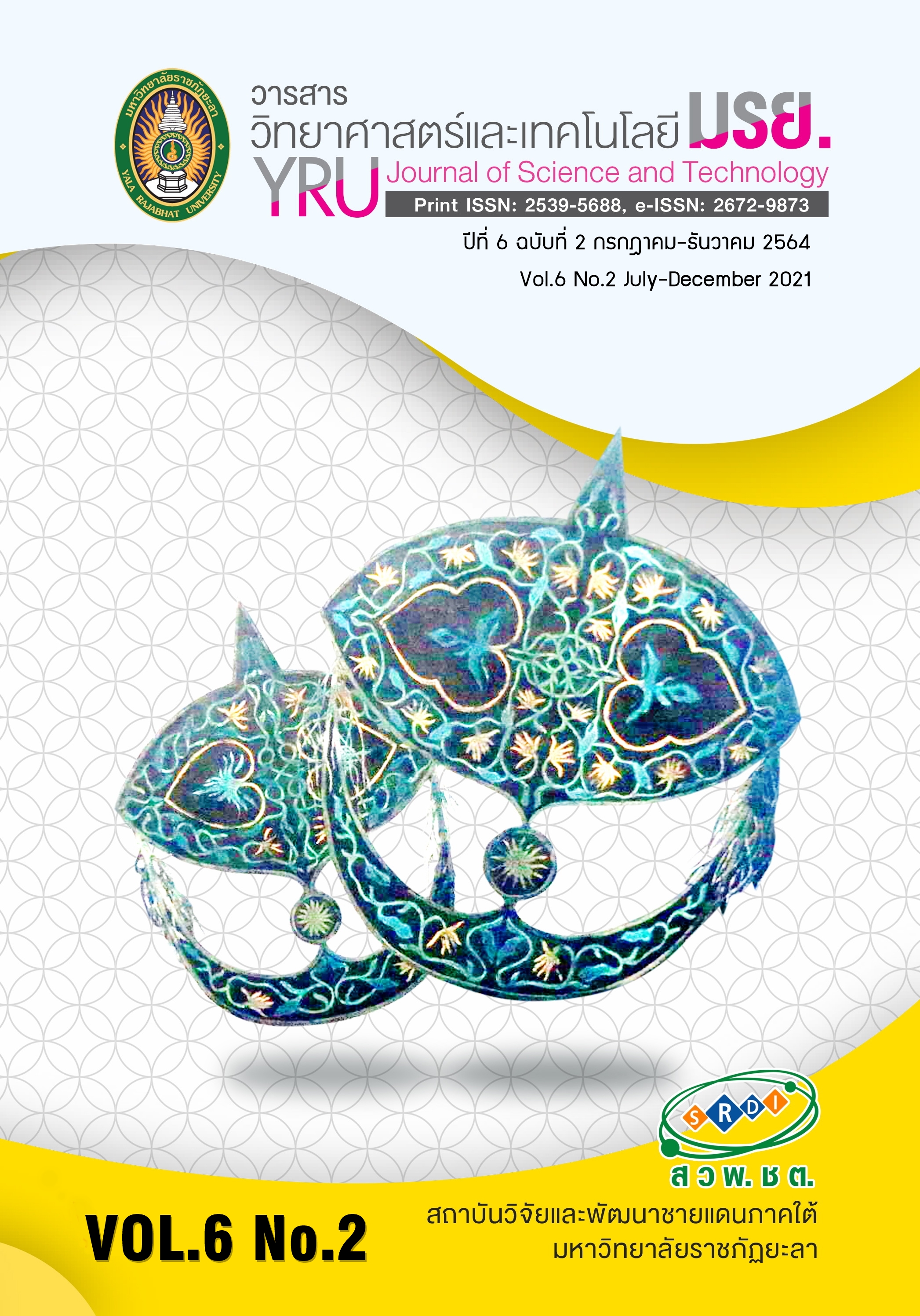การพัฒนาวิธีการตรวจหาปริมาณไซบูทรามีนในกาแฟลดน้ำหนัก ด้วยเทคนิคโครมาโทกราฟีของเหลวสมรรถนะสูง
Main Article Content
บทคัดย่อ
ไซบูทรามีน เป็นหนึ่งในสารต้องห้ามที่ไม่อนุญาตให้มีในผลิตภัณฑ์เสริมอาหารลดน้ำหนัก สารนี้มีผลข้างเคียงต่อสุขภาพของผู้บริโภค เช่น ความเจ็บป่วยทางจิต และภาวะหัวใจล้มเหลว ดังนั้นวิธีที่ใช้ตรวจหาปริมาณไซบูทรามีนจึงมีความสำคัญ ในงานวิจัยนี้เทคนิคโครมาโทกราฟีของเหลวสมรรถนะสูง โดยมีตัวตรวจวัดชนิดไดโอดอาเรย์ (HPLC-DAD) ได้ถูกพัฒนาสำหรับวิเคราะห์หาปริมาณสารไซบูทรามีนในกาแฟลดน้ำหนัก สภาวะการแยกสาร ประกอบด้วยคอลัมน์ C18 และใช้สารละลายแอมโมเนียมแอซีเตท ความเข้มข้น 0.025 โมลาร์ และอะซิโตไนไตรล์เป็นเฟสเคลื่อนที่ โดยมีระบบการแยกชนิดปรับสัดส่วนตามเวลา ด้วยอัตราการไหล 0.5 มิลลิลิตรต่อนาที ความยาวคลื่นที่ตรวจวัด 230 นาโนเมตร จากผลการวิจัย พบว่า เวลาที่ใช้ในการวิเคราะห์ทั้งหมด 10 นาที ค่าความเป็นเส้นตรงอยู่ในที่ช่วง 0.5 - 50 ไมโครกรัม/มิลลิลิตร โดยมีค่าสัมประสิทธิ์การตัดสินใจ (R2) เท่ากับ 0.998 ค่าความเข้มข้นต่ำสุดที่สามารถวิเคราะห์ได้ (LOD) มีค่าเท่ากับ 0.1 ไมโครกรัม/มิลลิลิตร ค่าความเที่ยงอยู่ในช่วงที่ยอมรับได้ วิธีที่ได้พัฒนาขึ้นสามารถประยุกต์ใช้ในการวิเคราะห์หาปริมาณไซบูทรามีนในตัวอย่างกาแฟลดน้ำหนัก โดยมีค่าเฉลี่ยร้อยละการกลับคืน มากกว่า 84% ที่ระดับความเข้มข้นที่ศึกษา
Article Details
บทความ ข้อมูล เนื้อหา รูปภาพ ฯลฯ ที่ได้รับการเผยแพร่ในวารสารวิทยาศาสตร์และเทคโนโลยี มรย. นี้ ถือเป็นลิขสิทธิ์ของวารสารวิทยาศาสตร์และเทคโนโลยี มรย. หากบุคคลหรือหน่วยงานใดต้องการนำทั้งหมดหรือส่วนหนึ่งส่วนใดไปเผยแพร่ต่อหรือกระทำการใดๆ จะต้องได้รับอนุญาตเป็นลายลักษณ์อักษรจากวารสารวิทยาศาสตร์และเทคโนโลยี มรย. ก่อนเท่านั้น
เอกสารอ้างอิง
An, H., Sohn, H. & Chung, S. (2013). Phentermine, sibutramine and affective disorders. Clinical
Psychopharmacology and Neuroscience, 11(1), 7-12.
AOAC. (2013). Appendix K: Guidelines for dietary supplements and botanicals. AOAC Official Methods of
Analysis, 1-32.
Arterburn, D. E., Crane, P. K. & Veenstra, D. L. (2004). The efficacy and safety of sibutramine for weight loss:
a systematic review. Archives of internal medicine, 164(9), 994-1003.
Carvalho, J. M., Da Silva, A. R., Da Cunha, A. L. M. C., Aucélio, R. Q., Alberti, A. L. M. & Leandro, K. C.
(2012). Voltammetric determination of sibutramine in beverages and in pharmaceutical
formulations. Química Nova, 35(5), 988-992.
Cebi, N., Yilmaz, M. T. & Sagdic, O. (2017). A rapid ATR-FTIR spectroscopic method for detection of sibutramine adulteration in tea and coffee based on hierarchical cluster and principal component analyses. Food Chemistry, 229, 517-526.
Csupor, D., Boros, K., Dankó, B., Veres, K., Szendrei, K. & Hohmann, J. (2013). Rapid identification of
sibutramine in dietary supplements using a stepwise approach. Pharmazie, 68(1), 15-18.
De Carvalho, L. M., Martini, M., Moreira, A. P. L., De Lima, A. P. S., Correia, D., Falcão, T., et al. (2011).
Presence of synthetic pharmaceuticals as adulterants in slimming phytotherapeutic formulations
and their analytical determination. Forensic Science International, 204(1), 6-12.
Hammadi, R. & Almardini, M. A. (2014). A fully validated HPLC-UV method for quantitative and
qualitative determination of six adulterant drugs in natural slimming dietary supplements.
International Journal of Pharmaceutical Sciences Review and Research, 29(1), 171-174.
Krivohlavek, A., Žuntar, I., Ivešić, M., Andačić, I. M., Šikić, S. & Vrebčević, M. (2016). Sibutramine in slimming
food supplements on the Croatian market determined by validated high-pressure liquid
chromatography-electrospray tandem mass spectrometry method. Journal of Food and
Nutrition Research, 55(3), 222-228.
Morris, J. & Nguyen, S. (2018). Thai police ramp up action on fake slimming products as four Thai women
die [Online]. Retrieved April 25, 2019, from: https://www.thaiexaminer.com/thai-news-foreigners/
/06/01/.
Popescu, A. M. & Radu, G. L. (2015). Detection of adulterants by FTIR and GC-MS in herbal slimming
food supplements. UPB Scientific Bulletin, Series B, 77(4), 221-230.
Qi, P., Hong, H., Liang, X. & Liu, D. (2009). Assessment of benzoic acid levels in milk in China. Food control,
(4), 414-418.
Rebiere, H., Guinot, P., Civade, C., Bonnet, P. A. & Nicolas, A. (2012). Detection of hazardous weight-loss
substances in adulterated slimming formulations using ultra-high-pressure liquid chromatography
with diode-array detection. Food Additive and Contaminants, 29(2), 161-171.
World Health Organization. (2020). Obesity and overweight [Online]. Retrieved April 16, 2020, from: https://www.who.int/news-room/fact-sheets/detail/obesity-and-overweight.
Yu, Z., Wei, Q., Fan, Q. & Wan, C. (2010). A simple and convenient method for simultaneous determination
of four major species of illegal additives in slimming health food. Journal of Liquid
Chromatography & Related Technologies, 33(4), 452-461.
Zygler, A., Wasik, A. & Namiesnik, J. (2009). Analytical methodologies for determination of artificial
sweeteners in foodstuffs. Trends in Analytical Chemistry, 28(9), 1082-1102.


